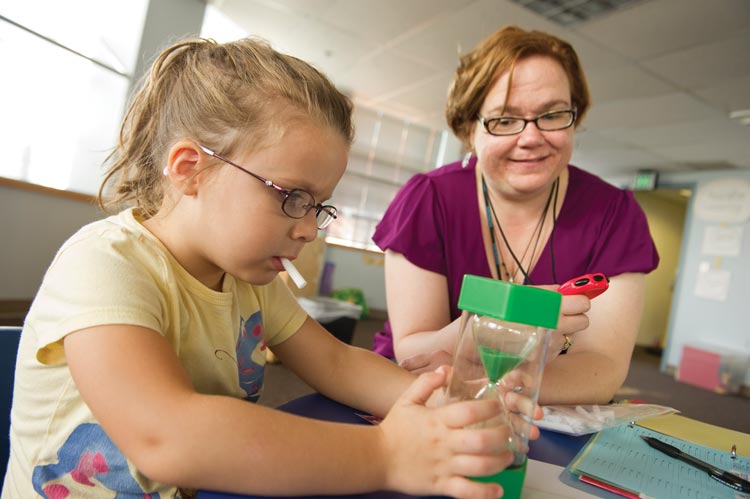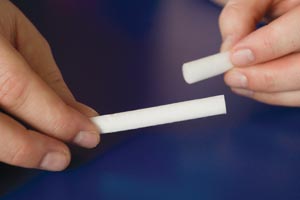Researchers swap the dreaded needle and syringe for a simple foam swab.
by Melissa Hendricks
Photos by Will Kirk
“You’re first?” Shelly Eisbach, PhD, RN, asks a three-year-old boy with large brown eyes. The boy and two other preschoolers are seated at a pint-sized table in a light-filled room at the Johns Hopkins Bayview Medical Center.
The boy nods. He is holding a toy hourglass filled with bright green sand. Eisbach hands him a foam swab about the size of a short pencil. The boy sticks one end in his mouth and flips the hourglass. Then Eisbach gives the boy’s mother, standing beside her son, a shorter swab. She, too, places the foam in her mouth.

Eisbach counts down the time using her own digital timer. At one-and-a-half minutes, she announces, “Time is up.” The boy and his mom hand their now-soggy foam pieces to Eisbach, who slips each one into a separate plastic test tube and gives the boy a Sponge Bob sticker. Eisbach then repeats the process with the two other children and their moms.
The families in the room attend an intensive outpatient therapeutic learning center for low-income families. The children have been referred here because they have shown serious behavioral problems that may be signs of mental health issues such as hyperactivity. Their moms are here to learn parenting skills that may help avert those problems and reduce their own stress levels, which are significant.
And Eisbach is here to collect their saliva.
She is studying whether the parenting skills program is effective. Part of the research protocol involves monitoring stress hormone levels. The easiest way to assess those hormones is by measuring them in spit. So at precisely 10:30 each morning, Eisbach visits the parenting center carrying a wicker basket full of foam swabs, test tubes, and Sponge Bob and princess stickers.
Eisbach’s study is one of several being conducted with the assistance of the Johns Hopkins University School of Nursing’s new Center for Interdisciplinary Salivary Bioscience Research. It is also one of hundreds of studies that the Center’s director, biobehavioral scientist Douglas Granger, PhD, has helped design.
A few drops of spit, a wealth of information
After two decades in the field, Granger is one of the world’s top experts in salivary bioscience. He’s developed methods for collecting saliva and analyzing the many chemicals the body can secrete into this fluid. He’s forged collaborations with a broad range of scientists interested in using his methods, and used salivary analysis as part of his own extensive research on social behavior, parent-child relationships, and stress.

Spit, says Granger, is a priceless research material. Scientists have found some 2,000 substances in its watery depths, including hormones, such as estrogen and testosterone; environmental chemicals, such as the plastics component Bisphenol A; and metabolites of nicotine, caffeine, and heroin. Each of these substances, or “analytes,” says Granger, is a clue to understanding the human experience.
While the blood sample remains the preferred method for diagnosing illness, he says, “the number of studies using salivary analytes as a research tool has increased at a very rapid rate in the past decade. My goal is to spread that knowledge.”
Granger’s interest in saliva science began when he was a graduate student at UC Irvine working with children with serious behavior problems. Besides focusing on social and psychological aspects of behavior, he wanted to understand the biological factors underlying such behavior. At first he thought he’d use blood samples to measure endocrine factors such as the stress hormone cortisol and immune factors that might correlate to particular behaviors. But getting families to consent to blood draws, he quickly learned, was difficult. Kids just didn’t like it.
Eventually, a journal article led Granger to try a different approach: instead of using blood, the article suggested it was possible to measure cortisol in saliva. Granger tried the technique, found it worked, refined the method and went on to lead and collaborate on dozens of studies exploring salivary cortisol’s relationship to behavior.
“Once we demonstrated the value of measuring cortisol in saliva, it was a natural next step to wonder what else could we do,” says Granger. The answer was, a lot.
Fine-tuning the science
In subsequent years, during which he moved on to Penn State to direct the Behavioral Endocrinology Laboratory, his teams developed salivary assays for a raft of analytes including testosterone, estradiol, progesterone, antibodies, C-reactive protein, and the stress-related enzyme alpha-amylase.

He also refined every detail of the collection and analysis procedures, including the gross, if scientifically important, question: Which gives better research results, drool or saliva collected by swab? The answer turns out to be: it depends. Some chemicals (such as progesterone) are measured more accurately if a volunteer drools into a cup, Granger found. For other substances, it’s best to collect the saliva by having subjects mouth an absorbent material—the spongy foam swabs.
Once Granger started publicizing his results, researchers in a broad range of disciplines—from anthropology to economics—began contacting him to learn how to use these methods. Those inquiries spawned collaborations with economists to use salivary biomarkers to study competitiveness in matrilineal and patriarchal societies. He helped a smoking-prevention organization design studies to measure a nicotine metabolite as a way to gauge the effectiveness of its campaigns. He even worked on a study comparing salivary stress hormone levels in dogs and their owners.
Future insights from this fluid
Now at Hopkins, Granger continues to assist others whose work hinges on his own. One of them is Shelly Eisbach.
The families enrolled in her study come from environments plagued with stress, says Eisbach, who is the Morton and Jane Blaustein Fellow in Psychiatric and Mental Health Nursing and who is working on the project under the direction of her mentor, professor Debbie Gross, DNSc, RN. Most of the parents are raising their children alone and living in impoverished neighborhoods with high rates of crime, drug abuse, and violence. “The children,” notes Eisbach, “score in the clinical range on a child behavior checklist, and their parents score in the 99th percentile on an index of parental stress.”
To assess whether the parenting skills training program can improve those scores, Eisbach uses conventional behavioral science metrics, such as the 100-question Child Behavior Check-list and the 36-item Parenting Stress Index. But with Granger’s help she is also analyzing salivary cortisol and alpha-amylase.
The scientists are eager to see whether the parenting-skills training can help bring those levels closer into sync or attunement. “It would be great to have a biological method of measuring whether a treatment works or not,” says Eisbach.
Many more studies are planned or in the works. Among other projects, Granger is refining assays for detecting infectious agents, including cytomegalovirus and Epstein-Barr virus, in saliva. He’s also collaborating with researchers who are recording salivary cortisol in nursing students using training simulators. And he’s planning to run “spit camps” at the School, workshops where researchers from across the scientific spectrum can come to learn salivary bioscience. He says he will continue to seek out and welcome collaborators on new projects.
“My focus is collaborate, collaborate, collaborate,” says Granger, “find the best people working on those problems and help them. That’s what this Center is about, and Hopkins is the right place for that” because of its extensive and diverse research endeavors. “This environment is infectious. To me, it’s like being in Disneyland.”
To learn more about Doug Granger and his work, visit www.nursing.jhu.edu/saliva.